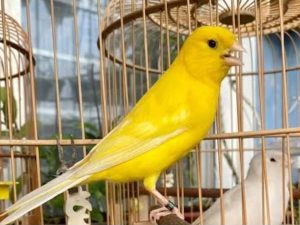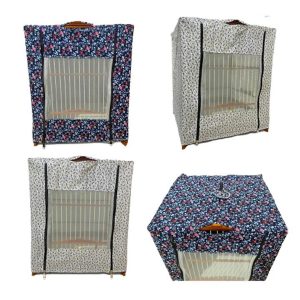I. Introduction
Canaries, known for their vibrant colors and melodious songs, have been cherished as companion birds for centuries. Originating from the Macaronesian Islands, including the Canary Islands, these small songbirds have adapted to a variety of climates. However, as domesticated pets, they rely on their human caretakers for their well-being, especially in climates different from their natural habitat.
Winter can be a challenging time for canary owners. Unlike in their temperate natural environments, domestic canaries face the risk of exposure to colder and more variable indoor temperatures. It’s crucial to understand that these birds are sensitive to rapid temperature changes and can suffer from cold stress, which can lead to health complications. Therefore, maintaining a warm and stable environment during the colder months is essential for their health and happiness.
This article will delve into the various aspects of keeping your canary comfortable and healthy during winter. From understanding the ideal temperature range to dietary adjustments and health monitoring, we aim to provide comprehensive guidance for all canary enthusiasts. Whether you are a new canary owner or have been enjoying the company of these delightful birds for years, this guide will offer valuable insights into the best practices for canary care in winter.

II. Understanding Canary Biology in Relation to Temperature
Canaries, with their origins in the mild, temperate climates of the Macaronesian Islands, have a biological makeup that is finely tuned to specific environmental conditions. Understanding this aspect of their biology is crucial for providing the appropriate care during winter months in different climatic regions.
A. Natural Habitat and Climate Adaptation
- Origin and Adaptation: Canaries are naturally adapted to a moderate climate, with relatively stable temperatures throughout the year. In their native habitat, they experience a range of weather conditions, but extreme cold is not typically one of them.
- Physiological Response to Temperature: These birds have a high metabolism and are sensitive to temperature changes. Their small size and surface area to volume ratio make them more susceptible to rapid heat loss in cold environments.
B. Temperature Effects on Health and Behavior
- Behavioral Changes: In colder temperatures, canaries may become less active, eat more to maintain energy, or fluff up their feathers to trap heat.
- Health Implications: Prolonged exposure to cold can lead to stress, weakened immune systems, and respiratory issues in canaries. It’s essential to observe any changes in behavior, appetite, or physical appearance that could indicate discomfort or health issues related to temperature.
C. The Ideal Temperature Range
- Comfort Zone: Canaries are comfortable in temperatures ranging from about 65 to 75 degrees Fahrenheit (18 to 24 degrees Celsius). This range supports their natural behavior and physiological needs.
- Avoiding Temperature Fluctuations: Sudden changes in temperature can be stressful and harmful. It’s important to keep the temperature in their living environment as stable as possible, especially during the winter months.
Understanding the temperature needs of your canary is not just about providing warmth; it’s about recreating an environment that closely mirrors their natural habitat. This understanding forms the basis for creating a comfortable, healthy winter environment for these sensitive and delightful birds.
III. Preparing the Environment
Creating a warm and stable environment for your canary during winter months is essential. Canaries are not just sensitive to cold temperatures but also to sudden changes in their environment. Thus, careful attention must be paid to their living conditions to ensure they remain healthy and comfortable.
A. Ideal Temperature Range for Canaries
- Optimal Conditions: The ideal temperature for canaries is between 65 to 75 degrees Fahrenheit (18 to 24 degrees Celsius). This range should be maintained consistently to prevent stress and health issues.
- Monitoring Temperature: Use a reliable thermometer to monitor the temperature near your canary’s cage regularly. This helps in ensuring that the environment stays within the ideal range.
B. Maintaining a Stable Temperature
- Heaters and Thermostats: Use room heaters with thermostats to maintain a consistent temperature. The thermostat will prevent the room from becoming too hot or too cold.
- Placement of Cage: Keep the cage away from windows, doors, and areas where there might be drafts. Also, avoid placing the cage too close to the heater to prevent overheating.
C. Protecting from Drafts and Direct Heat Sources
- Draft Prevention: Ensure that the room where the canary is kept is free from drafts. Check for any gaps in windows or doors and seal them if necessary.
- Avoiding Direct Heat: Direct heat sources like fireplaces or direct sunlight through a window can cause overheating and should be avoided. Canaries need a warm but not hot environment.
D. Lighting and Photoperiod
- Importance of Light: Adequate lighting is important for canaries, especially during shorter winter days. It helps maintain their circadian rhythm and overall health.
- Artificial Lighting: If natural light is not sufficient, consider using artificial bird-safe lighting to provide 10-12 hours of light per day. This mimics the natural photoperiod and helps in maintaining their natural cycle.
By taking these steps to prepare your canary’s environment for winter, you can ensure that your feathered friend stays warm, healthy, and happy during the colder months. It’s a blend of maintaining the right temperature, ensuring the absence of drafts, and providing adequate lighting that creates an ideal winter haven for your canary.
IV. Nesting and Bedding
During the winter months, providing a cozy and insulated nesting area is crucial for your canary’s comfort and health. The right nesting and bedding materials play a significant role in keeping your bird warm and secure.

A. Choosing the Right Nesting Materials
- Soft and Insulating Materials: Use soft, insulating materials like cotton, soft paper, or special nesting fibers available at pet stores. These materials help retain heat and provide a comfortable space for your canary.
- Avoiding Hazardous Materials: Steer clear of materials that could be harmful if ingested or that might entangle the bird’s feet. Avoid using materials like wool or synthetic fibers that can unravel easily.
B. Setting Up a Comfortable Nesting Area
- Location of the Nest: Place the nest in a sheltered part of the cage, away from direct drafts or heat sources. The location should be quiet and undisturbed to provide a sense of security.
- Size and Accessibility: Ensure the nest is spacious enough for your canary to move comfortably but cozy enough to retain heat. It should be easily accessible and securely attached to the cage.
C. Bedding for Additional Warmth
- Layering the Cage Floor: Add an extra layer of bedding on the cage floor to provide additional insulation. Materials like paper-based bedding or aspen shavings are good options as they are safe and absorbent.
- Regular Cleaning: Keep the bedding clean and dry, changing it regularly to maintain hygiene and prevent the growth of mold or bacteria, which can be harmful in a warm, enclosed environment.
D. Monitoring Nest Conditions
- Regular Checks: Regularly check the nest and bedding for signs of wear, dampness, or soiling. A clean and well-maintained nest is essential for the health of your canary.
- Adjustments for Comfort: Observe your canary’s behavior towards the nest and make adjustments as needed. Some birds may prefer more or less material, or a different arrangement.
By providing a well-prepared nesting and bedding area, you can significantly enhance your canary’s comfort during the cold season. This not only ensures they stay warm but also gives them a sense of security and well-being, which is crucial for their overall health.
